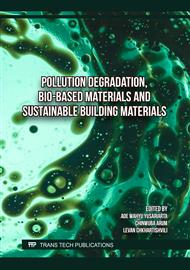[1]
M. Rani, Meenu, and U. Shanker, The role of nanomaterials in plastics biodegradability, Biodegradability of Conventional Plastics: Opportunities, Challenges, and Misconceptions, Elsevier, 2023, Pages 283-308
DOI: 10.1016/b978-0-323-89858-4.00012-9
Google Scholar
[2]
H. A. Maddah, Polypropylene as a Promising Plastic: A Review, American Journal of Polymer Science 2016, 6(1): 1-11.
Google Scholar
[3]
A. Alsabri, F. Tahir, S. G. Al-Ghamdi, Life-Cycle Assessment of Polypropylene Production in the Gulf Cooperation Council (GCC) Region, Polymers 2021, 13, 3793
DOI: 10.3390/polym13213793
Google Scholar
[4]
D. S. Achilias, C. Roupakias, P. Megalokonomos, and A. A. Lappas, E. V. Antonakou, Chemical recycling of plastic wastes made from polyethylene (LDPE and HDPE) and polypropylene (PP), Journal of Hazardous Materials, Volume 149, Issue 3, 19 November 2007, Pages 536-542.
DOI: 10.1016/j.jhazmat.2007.06.076
Google Scholar
[5]
K. Lingkungan, "National Plastic Waste Reduction Strategic Actions for Indonesia."
Google Scholar
[6]
M. D. Sampers, D. Bartomeu, M. P. Arietta, J. M. Ferri, and J. L. Martinez, Interference of Biodegradable Plastics in the Polypropylene Recycling Process, Materials 2018, 11(10), 1886;.
DOI: 10.3390/ma11101886
Google Scholar
[7]
N. Vidakis, M. Petousis, L. Tzounis, A. Maniadi, E. Velidakis, N. Mountakis, D. Papageorgiou, M. Liebscher, V. Mechtcherine, Sustainable Additive Manufacturing: Mechanical Response of Polypropylene over Multiple Recycling Processes, Sustainability 2021, 13, 159.
DOI: 10.3390/su13010159
Google Scholar
[8]
M. M-Lopez, G. M-Barrera, R. S. Delgado, O. Gencel, Recycling polypropylene and polyethylene wastes in production of polyester based polymer mortars, Construction and Building Materials, Volume 274, 8 March 2021, 121487
DOI: 10.1016/j.conbuildmat.2020.121487
Google Scholar
[9]
V. Srebrenkoska, G. B. Gaceva, M. Avella, M. E. Errico, G. Gentile, Recycling of polypropylene-based eco-composites, Polymer International, Volume57, Issue11
DOI: 10.1002/pi.2470
Google Scholar
[10]
A. Vardai, T. Lummerstorfer, C. Pretschuh, M. Jerabek, M. Gahleitner, G. Faludi, J. Moczo, B. Pukanszky, Comparative study of fiber reinforced PP composites: Effect of fiber type, coupling and failure mechanisms, Composites Part A: Applied Science and Manufacturing, Volume 133, June 2020, 105895.
DOI: 10.1016/j.compositesa.2020.105895
Google Scholar
[11]
A. Ashori, dan A. Nourbakhsh, A Comparative Study on Mechanical Properties and Water Absorption Behavior of Fiber-Reinforced Polypropylene Composites Prepared by OCC Fiber and Aspen Fiber, Published online in Wiley InterScience (www.interscience.wiley.com).
DOI: 10.1002/pc.20582
Google Scholar
[12]
M. Etcheverry and S. E. Barbosa, Glass Fiber Reinforced Polypropylene Mechanical Properties Enhancement by Adhesion Improvement, Materials 2012, 5(6), 1084-1113
DOI: 10.3390/ma5061084
Google Scholar
[13]
G. Colucci, H. Simon, D. Rancato, B. Martorana, and C. Badini, Effect of recycling on polypropylene composites reinforced with glass fibres, Journal of Thermoplastic Composite Materials, 1–17.
DOI: 10.1177/0892705715610407
Google Scholar
[14]
M. Neghab, A. Alipour, Respiratory Health Following Long Term Occupational Exposure to Fiberglass Dust, IRCMJ 2010; 12(2):145-150 ©Iranian Red Crescent Medical Journal.
Google Scholar
[15]
K. Minamoto, M. Nagano, T. Inaoka, T. Kitano, K. Ushijima, Y. Fukuda, and M. Futatsuka, Skin Problems among Fiber-Glass Reinforced Plastics Factory Workers in Japan, Industrial Health 2002, 40, 42–50.
DOI: 10.2486/indhealth.40.42
Google Scholar
[16]
M. R. Sanjay, S. Siengchin, J. Parameswaranpillai, M. Jawaid, C. I. Pruncu, and A. Khan, A comprehensive review of techniques for natural fibers as reinforcement in composites: Preparation, processing and characterization, Carbohydrate Polymers, Volume 207, 1 March 2019, Pages 108-121
DOI: 10.1016/j.carbpol.2018.11.083
Google Scholar
[17]
A. Karimah, M. R. Ridho, S. S. Munawar, D. S. Adi, R. Damayanti, B. Subiyanto, W. Fatriasari, A. Fudholi, A review on natural fibers for development of eco-friendly bio-composite: characteristics, and utilizations, Journal of Materials Research and Technology, Volume 13, July–August 2021, Pages 2442-2458.
DOI: 10.1016/j.jmrt.2021.06.014
Google Scholar
[18]
A. Arbelaiz, B. Fernandez, J. A. Ramos, A. Retegi, R. Liano-ponte, and I. Mondragon, Mechanical properties of short flax fibre bundle/polypropylene composites: Influence of matrix/fibre modification, fibre content, water uptake and recycling, Composites Science and Technology 65 (2005) 1582–1592
DOI: 10.1016/j.compscitech.2005.01.008
Google Scholar
[19]
X. Chen, Q. Guo, and Y. Mi, Bamboo fiber-reinforced polypropylene composites: A study of the mechanical properties, Journal of Applied Polymer Science, Volume 69, Issue10.
Google Scholar
[20]
Y. Feng, Y. Hu, G. Zhao, J. Yin, and W. Jiang, Preparation and mechanical properties of high-performance short ramie fiber-reinforced polypropylene composites, Journal of Applied Polymer Science, Vol. 122, 1564–1571 (2011).
DOI: 10.1002/app.34281
Google Scholar
[21]
L. Cheng, S. Duan, X. Feng, K. Zheng, Q. Yang, H. Xu, W. Luo, and Y. Peng, Ramie-degumming methodologies: A short review, Journal of Engineered Fibers and Fabrics, Volume 15, January-December 2020.
DOI: 10.1177/1558925020940105
Google Scholar
[22]
S. R. D. Petroudy, Physical and mechanical properties of natural fibers, Advanced High Strength Natural Fibre Composites in Construction, Elsevier.
DOI: 10.1016/b978-0-08-100411-1.00003-0
Google Scholar
[23]
S. Habibie, N. Suhendra, B. A. Setiawan, M. Hamzah, N. Aisah, D. A. Fitriani, R. Tasomarra, M. Anggaravidya, Prospect of Ramie Fiber Development in Indonesia and Manufacturing of Ramie Fiber Textile-based Composites for Industrial Needs, an Overview, International Journal of Composite Materials, 2021; 11(3): 43-53
Google Scholar
[24]
K. O. Reddy, C. U. Maheswari, M. Shukla, J. I. Song, and A. V. Rajulu, Tensile and Structural Characterization of Alkali Treated Borassus Fruit Fine Fibers, Composite: Part B 44 (2013) 433 – 438. (17)
DOI: 10.1016/j.compositesb.2012.04.075
Google Scholar
[25]
A. Gomes, K. Goda, and J. Ohgi, Effects of Alkali Treatment to Reinforcement on Tensile Properties of Curaura Fiber Green Composite, JSME International Journal Series A vol. 47, no. 4, 2004.(18)
DOI: 10.1299/jsmea.47.541
Google Scholar
[26]
K. O. Reddy, C. U. Maheswari, M. Shukla, and A. V. Rajulu, Chemical composition and structural characterization of Napier grass fibers, Materials Letters, Volume 67, Issue 1, 15, Pages 35-38.(19)
DOI: 10.1016/j.matlet.2011.09.027
Google Scholar
[27]
A. Ashori, dan A. Nourbakhsh, A Comparative Study on Mechanical Properties and Water Absorption Behavior of Fiber-Reinforced Polypropylene Composites Prepared by OCC Fiber and Aspen Fiber, Published online in Wiley InterScience (www.interscience.wiley.com).(20)
DOI: 10.1002/pc.20582
Google Scholar


